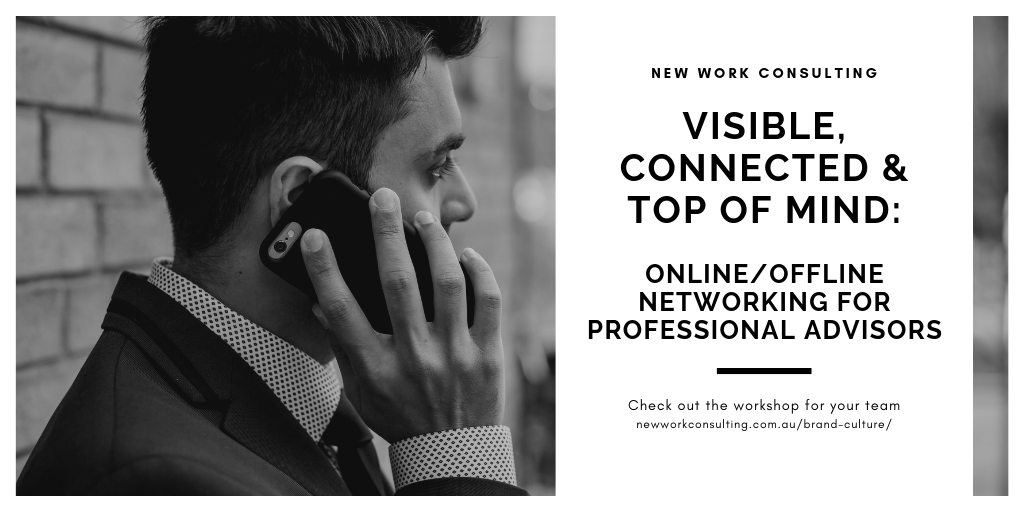Online and offline networking that WORKS
What professional people need to do
This week I was putting together a visual flow chart of networking activities for a client in professional services, and it reminded me of one of my favourite questions:
What are the main actions that move the needle?
When it comes to professional advisors and consultants, the thing that makes the most difference to business growth is real-life human contact. This is because professional people are building long-term business relationships that require significant commitment from clients… and that requires the establishment of rapport and trust. This happens quickest through face-to-face meetings where you can chat about the potential client’s business problem and start to offer insight, or when you can demonstrate how you can help through a boardroom presentation to the leadership team.
The question then always becomes: How do I get in front of the ideal client to have these conversations?
What I see a lot of is:
· Frustration that clients seem to forget to refer others to the business, even though they love the work.
· Reluctance to spend time networking, because experience has been that it is awkward and/or a waste of time, or because there isn’t much time available to get out of the office to network.
· No real grasp on how LinkedIn can be used simply and powerfully, in targeted ways, to achieve specific goals.
· Overwhelm at the pace of change in digital marketing and feeling at a loss as to which tactics to choose, because of a lack of a clear, strategic plan.
The trouble is that the great majority of professional people use these tactics haphazardly, rather than in a purposeful, structured way – like the networking flowchart that I mentioned at the beginning of this article.
To get in front of the ideal client and be given the opportunity to engage with them, you need a planned pathway to get there. Sure, sometimes these opportunities land in your lap through a chance meeting or referral… but I am now hearing a lot of leadership teams saying there is not enough of this to keep moving the business forward.
“Sometimes opportunities land in your lap… but a lot of leadership teams are saying there is not enough of this”
So which activities move the needle?

Experience has taught me that for professional services, highlights of your networking flow chart should include:
· Establishing trust and awareness in what you do as quickly as possible, in order to be given opportunities to discuss your work and its fit with a potential client. To do this, your tactic should be to gain as many quality introductions from your existing network as possible.
· If you have done some research on who in your network may be able to provide an introduction, and you have come up short… chances are you need to expand your network. This may mean attending some carefully chosen, quality networking events, to meet people face-to-face, because it’s much easier to book a coffee with someone you’ve already met.
· When you do get that meeting, preparing for a great first impression by researching the client, thinking about great questions to ask to learn about their problems, and being ready with clear and specific communication (verbally and in materials) on how you can help this particularclient.
· Scheduling follow-ups and keeping good records of your conversations so that you can continue to build a meaningful and mutually beneficial relationship.
If you are a visual person, you may be able to imagine how these key steps can start to form a flow chart! But everyone is different, and will have different considerations. Each of the steps above also have so much in them to unpack… they may be raising questions like, ‘But howdo I create clear and specific communication on what we provide?’ / ‘Whichare the right networking events for me?’
“Each step has so much in it to unpack…”
Pretty soon you’re in overwhelm, instead of having a clear and simple path to follow!
Long-term v short-term (move the needle) tactics
While building credibility and visibility over time through things like social media pages, media appearances, and posting online content are important, these are long-term tacticsthat should sit alongside your short-term tactics that most quickly move the needle. When you are very busy and can only do a few things well, your focus as a professional advisor should be a simple plan that you can execute to move relationships along weekly.
While I’ve provided some ideas to think about, I’m aware that I’ve posed even more questions! This idea of creating an online and offline networking plan is (alongside creating a personal brand) the most popular topic people ask for help on, most commonly as a team workshop, where they can learn the concepts and apply them into a personalised plan on the spot. If this topic has created more questions than answers for you, let me know how I can help! Julissa

